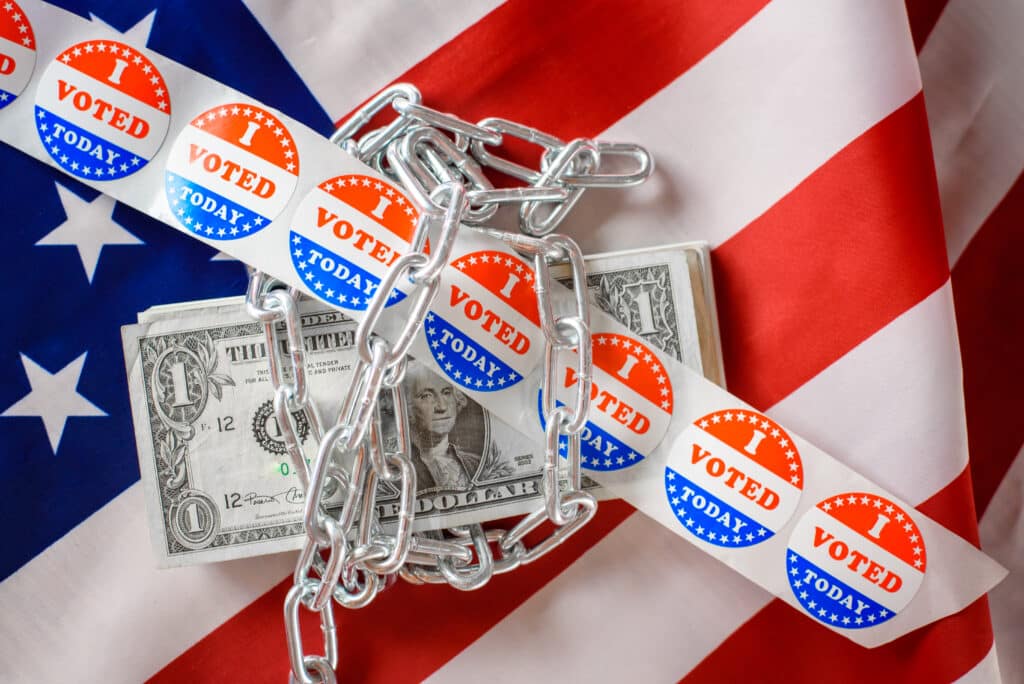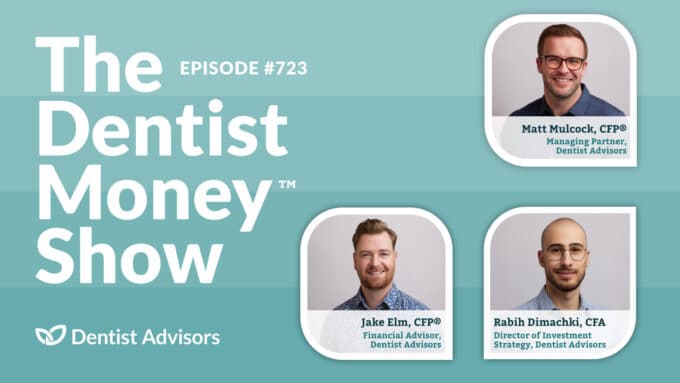TL;DR – Listen to the article post:
Investing during an election year can feel extra scary. A national election to determine the leader of the free world seems like something that could mess with the market and your portfolio. It is reasonable to fear the market repercussions of a contentious and polarizing political battle.
However, using history as your guide, you’ll find that the evidence supports a pretty mild market story. Remember, you’re investing in companies, not a political party. While, yes, who is in the White House has a ripple effect on many things, the market hasn’t been one of them.
If you allow yourself to get caught up in the intersection of elections and investing, there’s a high likelihood that you’ll end up making mistakes that will hold you back from growing your wealth.
Here are 3 election year investing myths:
Myth #1: Your portfolio cares who wins the election
You probably have feelings about who wins the election. But your portfolio doesn’t. The market has proven to be agnostic to which political party is in power.
Time in the market is far more important than who is in office. And data continues to prove this point. $1,000 invested in the S&P 500 when Franklin D. Roosevelt took office would be $22 million today. Since then, there have been eight democrat and seven republican presidents.
Elections end up with a clear winner and loser. But the only way you lose is if you believe it matters to the markets who wins or who loses the election. Remember, you’re playing the long game. And over the long run, your portfolio will not care about the outcome of the election 2024.
Myth #2: Stocks don’t do well during an election year
Nobody likes uncertainty. And election years tend to feel extra uncertain. So it would stand to reason that stocks might struggle in an election year. But the story of fear, uncertainty, and bad returns is often a result of a narrative created by the media. History and data tell a much different story.
Historically speaking, stocks have performed better than average in election years compared to non-election years. The average return of the S&P 500 during election years is 11.57%, which is higher than the historical average of 10.67% in all the other years.
There is still a lot of uncertainty with a major political battle to settle in November that brings a lot of consequences. You may be feeling all sorts of different emotions about who might win. But if history is the barometer, your odds of better returns are going to be higher than normal because it’s an election year, not in spite of it.
Myth #3: You can time the market based on the election
Charlie Munger once said, “The first rule of compounding is to never interrupt it unnecessarily.”
One of the biggest investment mistakes you can make is to get in and out of the market in anticipation of or in reaction to certain events. An example of this would be fleeing to cash because of a specific candidate. Doing so will interrupt the compounding effect required to grow your wealth.
Unfortunately, this is what many investors do when they get scared of what may or may not happen during an election.
I get it. It feels prudent and maybe even responsible to “wait and see what happens” before jumping back in. I’ve heard and felt this many times in my career. But the truth is that you’ll never be able to time these things with any level of precision or accuracy. Attempting it will only lead to lower returns and less wealth.
Conclusion
An economist with the Capital Group, Darrell Spence, was right when he said, “Presidents get far too much credit, and far too much blame, for the health of the U.S. economy and the state of the financial markets. There are many other variables that determine economic growth and market returns and, frankly, presidents have very little influence over them.”
Politics and presidents impact many things. The influence and consequences of elections ripple throughout the country and the world affecting billions of lives. But remember, history has shown that elections have no lasting effect on markets.
Instead of focusing on who wins the election, put your energy into keeping your emotions out of investing. Have a plan that aligns with your long term goals and focus on sticking with it. Your investments can win even if your party or candidate loses. You win by staying put no matter the outcome.
529 Plans
A 529 Plan is a tax-advantaged account that can be used to pay for educational expenses. The main type of 529 Plan is the Education Savings Plan. This is probably what you are most familiar with. You can contribute up to $18,000 per donor per beneficiary. That means if you are a married couple filing jointly, you can contribute $36,000 to each of your children per year. Some states set an overall max contribution which ranges from $235,000 to $575,000. You can find your state’s max contribution here.
The biggest benefit of a 529 is the potential tax savings. Withdrawals from a 529 are tax-free from federal and state income taxes if used for a qualifying educational expense. Additionally, some states will let you take a tax deduction or give you tax credits for contributing to your state’s 529.
The biggest disadvantage to consider is the limited use for the funds. While the government has relaxed the rules over time, you still have to use the funds for a qualified educational expense. Think tuition, books, room and board, trade school, grad programs, etc. If you want to use the funds for anything else, you’ll incur a 10% penalty.
The silver lining here is that you can change the beneficiary to a different child and you can roll over up to $35,000 of unused 529 funds to a Minor Roth IRA if you meet the requirements.
529 Plan TLDR;
Pro: Tax savings
Con: Fairly limited use of funds
Control level: Medium/High (you can change beneficiary but funds must be used for education).
Minor Roth IRAs
This is a popular savings vehicle for dentists with kids. It’s one of the perks of practice ownership! A Minor Roth IRA was designed to give kids a head start for retirement. However, there are more uses for a Minor Roth. To bring everyone up to speed, you can contribute up to $7,000 per year in 2024 to a Minor Roth IRA if you can prove that your child has earned income of an equal amount (e.g. modeling or working for the practice). The contributions go in after-tax but all the earnings are never taxed. Imagine if you contributed to your child’s Minor Roth for several years and those funds had potentially 50+ years to grow tax-free? Pretty sweet.
While the retirement benefits are huge, you can also use the funds for other things. For one, you can always access the contributions you made to the account. You paid your taxes on that money so the government doesn’t care. They just “lock” up the earnings portion until age 59½. Yes, we know – such a random age.
However, the government will not penalize you for using the funds for certain things like college education, unexpected emergency expenses, or a first-time home purchase. Your child will owe income tax on those dollars but won’t get hit with a 10% penalty for an early withdrawal.
Minor Roth IRAs TLDR;
Pro: Highest potential tax benefit and you can always access your contributions
Con: Earnings must be used for education, unexpected medical costs, first-time home purchase, or retirement
Control level: Medium/Low (you can withdraw the contributions but the funds completely transfer to your child at 18 or 21 depending on your state).
Brokerage accounts
A brokerage account is a savings account that allows you to buy stocks and bonds. You can use the account for whatever you’d like. There are no tax benefits. There are no penalties. This is both a pro and a con.
The taxes you’ll experience with a brokerage account are capital gains taxes. If you hold an investment for less than a year, you’ll pay short-term capital gains tax which is taxed at the same rate as your ordinary income. If you hold an investment for longer than one year, you’ll be taxed at the long-term capital gains tax rate which is 15% or 20% for most dentists.
While this seems like a con, the flexibility you’ll have can be more than worth it. You can use the funds to pay for your child’s first car, a wedding, backpacking across Europe together, etc. Think of it as paying a premium for maximum flexibility. If your child doesn’t end up needing funds for college (because they are so smart and got a full ride!), then the funds aren’t locked up with a penalty.
We see many dentists use this account for the benefit of maintaining flexibility.
Brokerage accounts TLDR;
Pro: Highest level of flexibility and no penalties associated with any withdrawals
Con: No tax benefits
Control level: High (you never have to transfer the funds to your child)
High yield savings accounts
If you have a shorter time frame for when you’ll need the funds for your child, consider a high yield savings account. As of August 2024, rates are around 4-5%. That is a pretty sweet return on your cash. As a general rule of thumb, we recommend using high yield savings accounts for cash needs within 2 years or for emergency funds.
High yield savings accounts TLDR;
Pro: Highest level of flexibility and no penalties associated with any withdrawals
Con: No tax benefits and no potential investment returns
Control level: High (you never have to transfer the funds to your child)
Paying for your child’s education is not a one-size-fits-all solution. Oftentimes, dentists use a combination of accounts. A great question to start off with is: how much of your child’s education do you want to pay for? All, some, or none? Some parents want to give their child the gift of covering the entire expense. Others want their child to have some skin in the game or have them pay for all of it. This is specific to your objectives.
Something to consider is: put your oxygen mask on before helping others. Keep in mind that tuition can be put on a loan. The same can’t be said for retirement. Compromising your retirement for the sake of your child’s education potentially puts you in a position where your children have to financially support you in your sunset years.
Here is a helpful way to think about it:
- We generally recommend a 20% savings rate – not including contributions to your kids’ accounts.
- If you have funds left over, then there is likely enough cash flow left over to save for your children.
- Ask yourself how much you’d like to cover for your child.
- Set up automatic contributions to the account(s) that fits your needs.
With the cost of tuition increasing, this decision is becoming increasingly important. With a little education and planning, you can make a huge difference in your kids’ futures.







